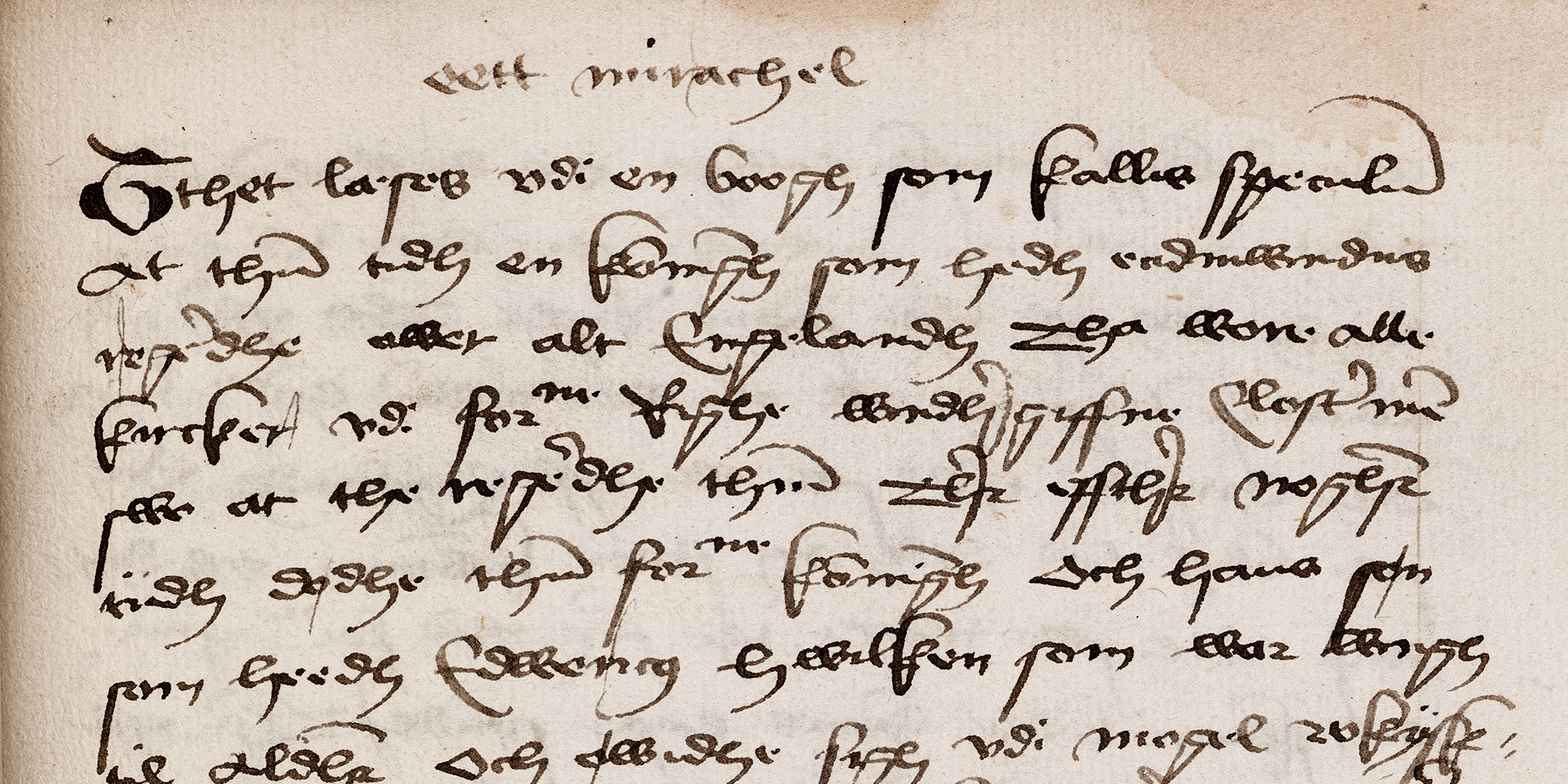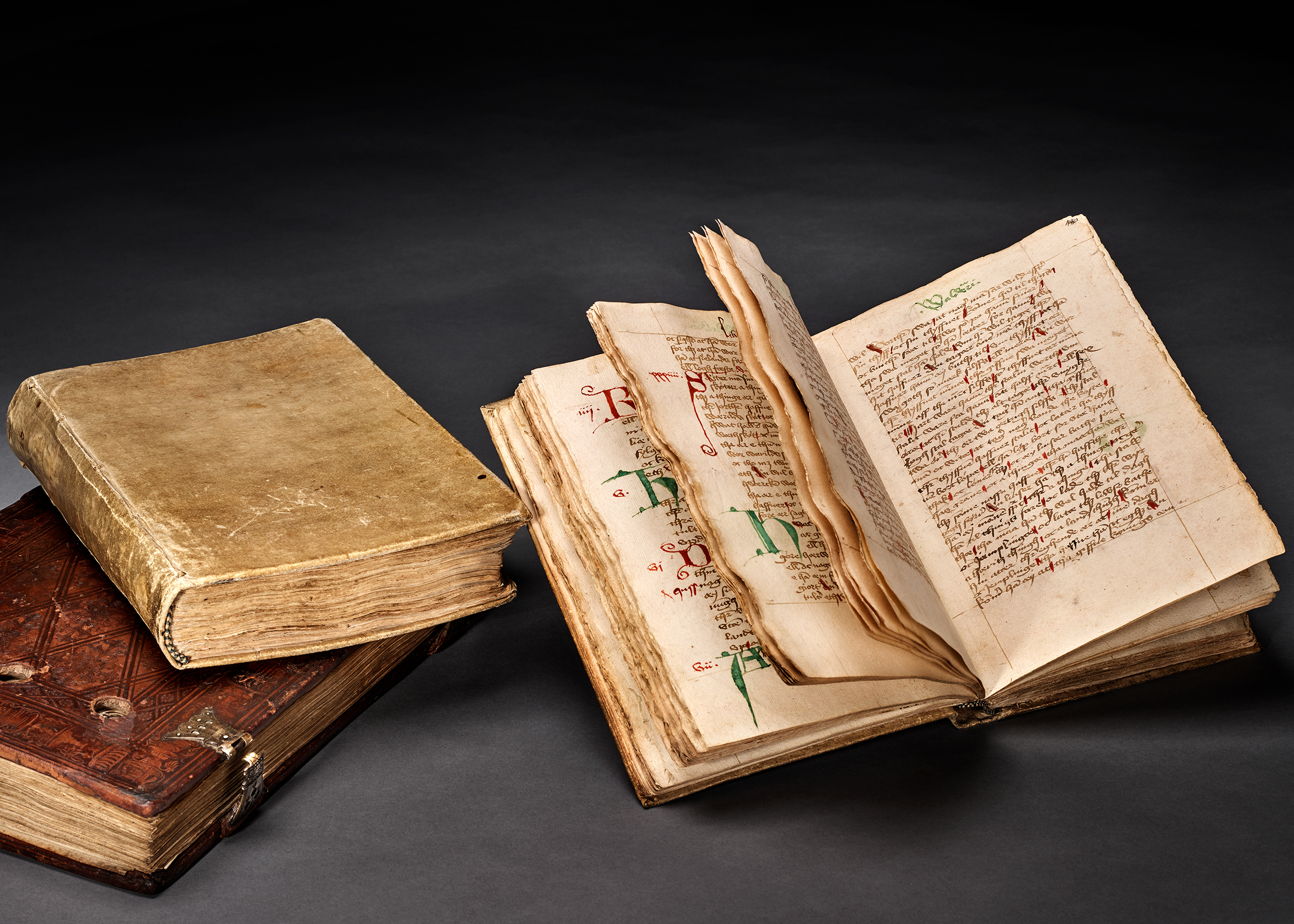An English Saint in a Danish Manuscript
The story of an English saint is found in a Danish lawbook from the late 15th century. A study of the provenance of AM 28 4to shows how this is not the only religious connection.

Hagiography, or legends about Christian saints, was a popular text genre in the Middle Ages. Many stories of saints and their deeds were translated into various vernacular languages, including Danish. In fact, some of the earliest manuscript fragments in Danish contain lives of saints.
One fully preserved text is found in AM 28 4to and contains the story of St. Dunstan, an English saint who lived in the tenth century and was the Archbishop of Canterbury.
The story in AM 28 4to tells mostly of Dunstan’s feud with Eadwig, king of England from 955-959. Disagreement between Eadwig and Dunstan, then abbot of Glastonbury, began on the day of Eadwig’s coronation, when the newly-crown king openly bedded a mistress -- a commoner, at that. The local nobles sought the advice of Dunstan who, enraged, pulled the young king from his bed and dragged him to the archbishop of Canterbury to repent for his sin. This led Eadwig to banish Dunstan and all of his monks from the kingdom.
After some time, the population slowly began to grow against Eadwig and his policies, eventually driving him out of England. Then, remembering the abbot Dunstan, they brought him back and installed him as archbishop of Canterbury, though not before they found the king’s mistress and sliced the sinews of her knees.
Paul Diderichsen (1931-37) writes in his Fragmenter af gammeldanske Haandskrifter (‘Fragments of Old Danish Manuscripts’) that the story of St. Dunstan in AM 28 4to can be dated to the late fifteenth century and derives from the thirteenth-century Speculum Historiale (‘Mirror of History’) by the Dominican friar Vincent of Beauvais, who died around 1264. That this Speculum is the source text is evident in the opening line of the text itself, which reads ‘Tthet læses vdi en boogh som kallis speculum’ (This is read in a book called Speculum).
The life of St. Dunstan is also known in the Icelandic Dunstanus saga, compiled by the monk Árni Laurentiusson in the fourteenth century. The Icelandic version is known in two manuscripts, AM 180 b fol. from around 1500 and NKS 267 fol. from the eighteenth century (Wolf 2013: 92). Árni mentions Vincent of Beauvais’ Speculum Historiale (‘epter þui sem saa meistare seger er dictat hefur Speculum Historiale’; Fell 1963: 25), which must have then influenced his retelling, though he also received material from other sources about St. Dunstan.
A Saint’s life in a legal manuscript?
The curious feature of the story of St. Dunstan in AM 28 4to is not, however, the fact the text exists — as said, lives of saints are known here and there in the Old Danish corpus. Rather, its placement within the manuscript is surprising. Apart from the St. Dunstan text, AM 28 4to is a legal manuscript, containing a mishmash of legal texts from Zealand, Scania, and even Gotland.
Although the manuscript can be divided into separate codicological units with different stages of production, there is no indication the story of St. Dunstan was written separately and later bound together with legal texts. Rather, it is found in a single codicological unit together with the legal texts on farm law (Gårdsretten), regal manifests (Håndfæstninger), and a description of the border between Denmark and Sweden (Grænseskel mellem Danmark og Sverige). The core codicological unit of the manuscript, however, consisting of ff. 4-90, contain two legal texts from Zealand: King Erik’s Provincial Law of Zealand (Eriks sjællandske Lov) and the younger redaction of the Church Law of Zealand (Sjællandske Kirkelov). It appears the other codicological units which make up this manuscript, containing both legal texts and the legend of St. Dunstan, may have been added later.

Both AM 23 4to (left) and AM 28 4to (right) contain texts written by Jens Mikkelsen Jyde, who was writing in Kalundborg in the 1490s.
Two Manuscripts from the Archbishop
The legend of St. Dunstan and the Church Law of Zealand are not the only religious connection in AM 28 4to. According to the slip of paper written by Árni Magnússon, the manuscript given by the archbishop of Lund, Birger Gunnersen, for the use of the episcopal see. The slip reads:
Istud legisterium est elemosina Domini Birgeri Archiepiscopi Lundensis etc. pro usu sedis Lundensis in Schania. ipso die Nativitatis Joannis Baptiste M.d. decimo qvinto.
This collection of laws is a pious donation from Birger, Archbishop of Lund etc. for the use of the See of Lund in Scania. On the day St. John the Baptist’s Nativity (24 June) 1515.
Curiously, this exact same information is found on a slip of paper in another manuscript, AM 23 4to, meaning both manuscripts had been in the possession of the archbishop. The connections between these two go further, in that the same hand is found in both manuscripts, specifically in legal texts from Zealand which in both manuscripts form cohesive codicological units. This hand has been identified (see Kroman 1942: viii) as that of Niels Mikkelsen Jyde (‘the Jutlander’), who would eventually become the scribe at the royal chancery.

AM-Slips from AM 28 4to (left) and AM 23 4to (right). Both slips give the same information about Birger Gunnersen’s donation to Lund. |
 |
According to a colophon on f. 53v in AM 23 4to, written by Niels Mikkelsen Jyde, the two Zealandic laws were written in Kalundborg in 1494. At the time, Birger Gunnersen was chancellor for Queen Dorothea, widow of King Christian I, who spent much of her time in Kalundborg. It may very well have been here Birger Gunnersen received Niels Mikkelsen’s copies of Zealandic laws. He then would have brought them with him to Lund, where he was installed as archbishop on 7 June 1497.
During his time as archbishop, Birger instituted an order of worship, the Sanctuarium Birgerianum, the manuscript of which is also found in the Arnamagnæan Collection, AM 292 fol.

Three Arnamagnæan manuscripts once belonged to Birger Gunnersen: AM 292 fol. (left bottom), AM 28 4to (left top), and AM 23 4to (right).
Contact
Seán Vrieland is an external lecturer at the Arnamagnæan Institute.
Telephone: +45 3533 7566
sean.vrieland@hum.ku.dk
Bibliography
Diderichsen, Paul 1931-37. Fragmenter af gammeldanske Haandskrifter. Copenhagen.
Fell, Christine Elizabeth 1963. Dunstanus saga. Copenhagen.
Kroman, Erik 1942. Danmarks gamle Landskabslove VII. Copenhagen.
Wolf, Kirsten 2013. The Legends of the Saints in Old Norse-Icelandic Prose. Toronto.
Contribute to Manuscript of the Month
Have something to say about one or more manuscripts in the Arnamagnæn Collection? Contribute to the column Manuscript of the Month to get your research out there! Write to Seán Vrieland (sean.vrieland@hum.ku.dk) for more details.
